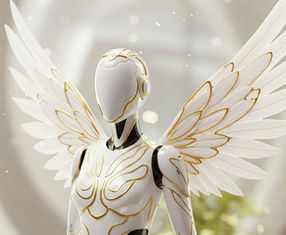What does the Future hold for Art in the age of AI?
- Tretyak
- Mar 18, 2024
- 6 min read
Updated: Mar 6
The Art of the Future: AI's Transformative Impact on Artistic Expression
The World of Art is no stranger to revolution. From the Renaissance, where new perspectives on realism and human anatomy transformed painting and sculpture, to the digital age, where photography, film, and computer graphics revolutionized visual expression, artists have continually embraced new tools and technologies to push the boundaries of creativity. Now, Artificial Intelligence (AI) is poised to become the next great disruptor in the art world, offering a palette of possibilities that were once confined to the realm of imagination. But what does the future hold for art in this age of intelligent machines? Will AI replace human artists, rendering human creativity obsolete? Or will it become a powerful tool for collaboration and innovation, amplifying human expression and opening up new frontiers of artistic exploration? Let's embark on a deeper exploration of the fascinating intersection of art and AI, examining the challenges, opportunities, and potential futures that lie ahead.

The AI Artist: Creator or Collaborator?
AI is already making its mark in the art world, generating stunning images that rival the works of human artists, composing music that evokes emotions, and even writing poetry that touches the soul. But the fundamental question remains: Can AI truly be considered an artist? Or is it simply a sophisticated tool in the hands of human creators, an extension of our own creative impulses?
The answer, like art itself, is multifaceted and open to interpretation. Some argue that AI lacks the consciousness, emotions, and lived experiences that fuel human creativity. They contend that art is an expression of the human soul, a reflection of our inner world and our unique perspective on reality. AI, they argue, can only mimic or imitate human creativity, lacking the depth and authenticity that comes from genuine human experience.
Others believe that AI's ability to generate novel and unexpected combinations of ideas, explore vast creative spaces beyond human comprehension, and even mimic different artistic styles, marks a new era of artistic expression, where the boundaries between human and machine creativity become increasingly blurred. They argue that AI can be a source of inspiration, a catalyst for new ideas, and a partner in the creative process, pushing the boundaries of art and challenging our understanding of what it means to be creative.
Perhaps the most fruitful approach lies in collaboration, where humans and AI work together, leveraging the strengths of both to create art that transcends the limitations of either alone. AI can be a powerful tool for generating ideas, exploring new techniques, and pushing creative boundaries, while humans can provide the critical judgment, emotional intelligence, and artistic vision to shape the final product, ensuring that it resonates with human emotions and experiences. This collaboration could lead to new forms of artistic expression, where human and artificial creativity merge to create something truly unique and transformative.

The Evolving Role of the Artist: Curator, Collaborator, and Critic
In the age of AI, the role of the artist may evolve, encompassing new skills and perspectives as AI becomes more integrated into the creative process:
Curator: The Artistic Guide: Artists may become curators of AI-generated content, selecting, refining, and contextualizing AI's output to create meaningful and impactful art. This involves not only appreciating the aesthetic qualities of AI-generated art but also understanding its underlying mechanisms, its potential biases, and its cultural and social implications. It's about guiding AI's creative potential and shaping its output to create art that resonates with human values and aspirations.
Collaborator: The Creative Partner: Artists may collaborate with AI, using it as a creative partner to explore new ideas, techniques, and forms of expression. This involves a dynamic interplay between human and artificial intelligence, where artists provide the inspiration, guidance, and critical judgment, while AI contributes its computational power, ability to explore vast creative spaces, and generate novel and unexpected combinations of ideas. This collaboration could lead to new forms of art that are both human and machine-made, blurring the lines between traditional artistic roles and challenging our understanding of authorship and creativity.
Critic: The Evaluator of AI Art: Artists may become critics of AI art, evaluating its aesthetic value, its originality, and its impact on society and culture. This involves developing a critical framework for understanding and evaluating AI art, considering its technical aspects, its creative merit, and its ethical implications. It's about engaging in a thoughtful and nuanced critique of AI art, contributing to the ongoing discourse about the role of AI in art and its potential impact on human creativity.

The Impact on Artistic Expression: New Forms, New Frontiers
AI has the potential to expand the boundaries of artistic expression, opening up new forms and frontiers that were previously unimaginable:
Generative Art: The Algorithmic Muse: AI can generate novel and unexpected visual forms, creating art that is both aesthetically pleasing and intellectually stimulating. This involves using algorithms and machine learning models to create art that is not explicitly programmed, allowing for serendipity and surprise in the creative process. Imagine AI generating intricate patterns, abstract shapes, and surreal landscapes that challenge our perception and spark our imagination.
Interactive Art: Engaging the Viewer: AI can create interactive art installations that respond to the viewer's presence and actions, creating dynamic and engaging experiences that blur the lines between art and reality. This involves using sensors, cameras, and other technologies to create art that reacts to the viewer's movements, emotions, and even thoughts, creating a personalized and immersive experience. Imagine an AI-powered art installation that changes its form and color based on the viewer's mood, or a virtual reality experience that transports the viewer to another world.
Personalized Art: Tailoring Art to Individual Experiences: AI can generate art that is personalized to the individual's preferences and experiences, creating unique and meaningful works of art that resonate with the viewer on a personal level. This involves using AI to analyze the viewer's data, such as their interests, preferences, and even their emotional state, to create art that is tailored to their unique identity. Imagine an AI system that generates a portrait that reflects your personality and emotions, or a music composition that evokes your deepest memories and feelings.
Cross-modal Art: Blending the Senses: AI can blend different artistic modalities, such as music, visuals, and language, creating new forms of artistic expression that transcend traditional boundaries. This involves using AI to create art that engages multiple senses, creating a more holistic and immersive experience. Imagine an AI system that generates music that visualizes your emotions, or a poem that paints a picture in your mind.

The Challenges and Opportunities:
Navigating the Ethical Landscape of AI Art
The rise of AI in art also presents challenges and opportunities that require careful consideration and proactive solutions:
Authorship and Ownership: Redefining Artistic Credit: Who owns the copyright to AI-generated art? Is it the AI, the developer who created the AI system, or the user who provides the prompts and guides the creative process? These questions raise legal and ethical challenges that need to be addressed as AI art becomes more prevalent and commercially viable. It's about redefining artistic credit and ensuring that AI is used ethically and responsibly in the creative process.
Bias and Representation: Ensuring Diversity and Inclusion: AI systems can inherit and amplify biases present in the data they are trained on, potentially leading to art that is discriminatory or exclusionary. It's crucial to address bias in AI development, promote diversity and inclusion in the data and algorithms, and ensure that AI art reflects the diversity and inclusivity of human society. This involves creating AI systems that are trained on diverse and representative datasets, as well as developing fairness-aware algorithms that mitigate bias and promote equitable outcomes.
Accessibility and Democratization: Making Art Accessible to All: AI has the potential to democratize art, making it more accessible to a wider audience by providing tools and platforms for creative expression that are accessible to everyone, regardless of their background or skill level. However, it's important to ensure that AI art does not become elitist or inaccessible, and that it benefits all members of society, not just a privileged few. This involves promoting access to AI art tools and education, supporting artists from diverse backgrounds, and creating a more inclusive and equitable art world.
The Future of Art and AI:
A Collaborative Canvas for Human Expression
The Future of Art and AI is a vast and uncharted canvas, where human creativity and Artificial Intelligence intertwine to create new forms of expression, challenge traditional boundaries, and expand our understanding of what it means to be creative. It's a future where artists and AI can collaborate, innovate, and inspire, creating art that is both beautiful and meaningful, reflecting the complexities and aspirations of human experience.
This collaborative future requires us to embrace the potential of AI while also addressing its ethical challenges, ensuring that AI is used responsibly and in a way that benefits all of humanity. It's about fostering a culture of creativity, innovation, and inclusion, where humans and AI can work together to create a more vibrant, diverse, and inspiring art world.
What role do you envision for AI in the future of art? Will it be a tool, a collaborator, or even a creator in its own right? How can we ensure that AI is used ethically and responsibly in the art world, promoting creativity, diversity, and accessibility? Share your perspectives and join the conversation!































































































AI is definitely shaking up the art world! It's fascinating to think about how AI-generated art blurs the lines of traditional creativity. While it raises questions about authorship, there's no denying its potential to push artistic boundaries in ways we haven't imagined. I'm curious to see how AI tools and human artists will continue to collaborate in the future.
Great! 😃